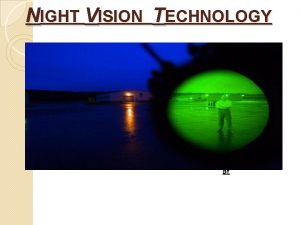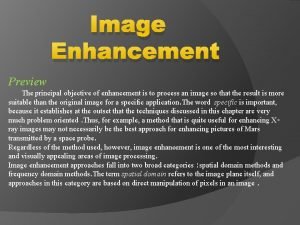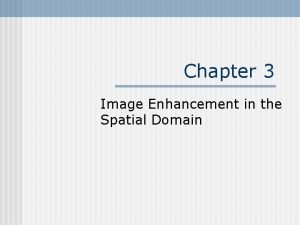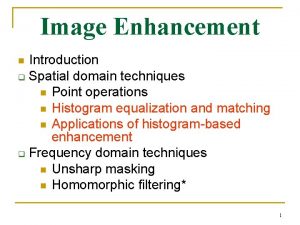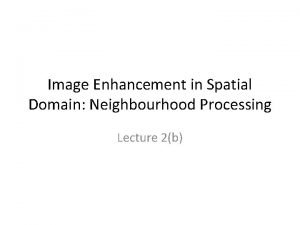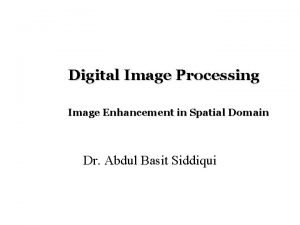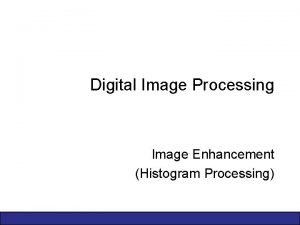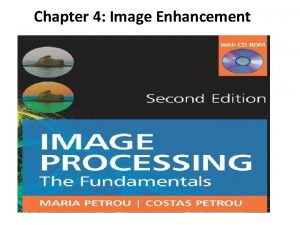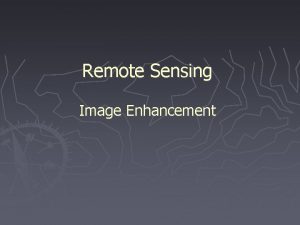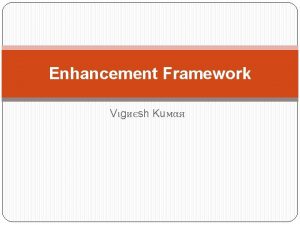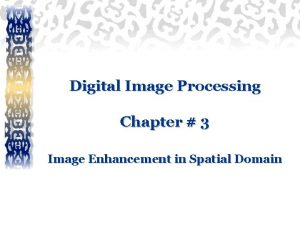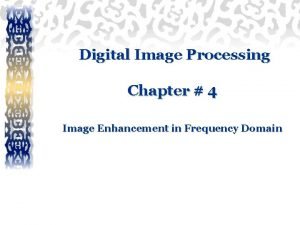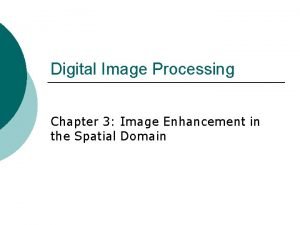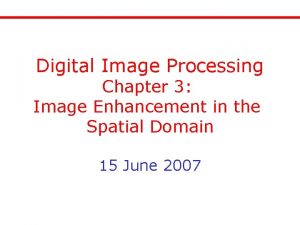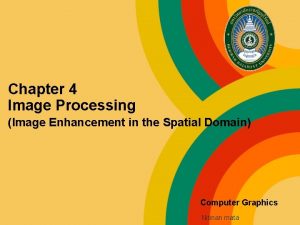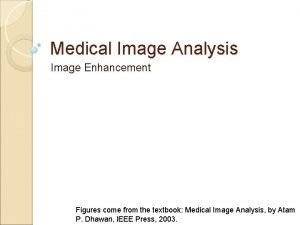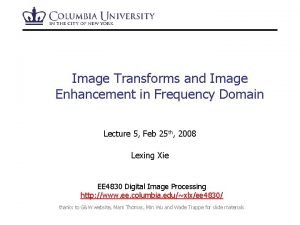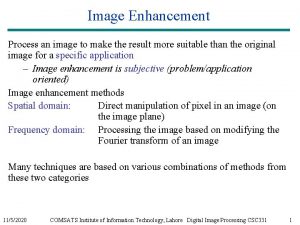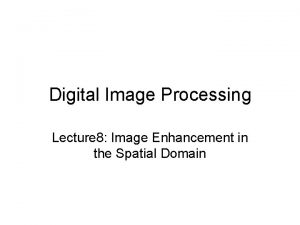Chapter 3 Image Enhancement Image Enhancement The principal






![Image Negatives Image in the range [0, L-1] It is useful in displaying medical Image Negatives Image in the range [0, L-1] It is useful in displaying medical](https://slidetodoc.com/presentation_image_h2/4cf31b7429e5bc9f4309ec053a380a9e/image-7.jpg)




























- Slides: 35

Chapter 3 Image Enhancement

Image Enhancement The principal objective of enhancement is to process an image so that the result is more suitable than the original image for a specific application The specific application may determine approaches or techniques for image enhancement Image enhancement approaches fall into two broad categories Spatial domain methods Frequency domain methods

Spatial Domain Methods • Procedures that operate directly on pixels. g(x, y) = T[f(x, y)] where – f(x, y) is the input image – g(x, y) is the processed image – T is an operator on f defined over some neighborhood of (x, y)

Spatial Domain Methods (x, y) • • Neighborhood of a point (x, y) can be defined by using a square/rectangular (common used) or circular subimage area centered at (x, y) • The center of the subimage is moved from pixel to pixel starting at the top of the corner

Spatial Domain Methods The smallest possible neighborhood is of size 1 x 1 s=T(r) ; gray-level transformation s, r : gray level

Gray Level Transformations
![Image Negatives Image in the range 0 L1 It is useful in displaying medical Image Negatives Image in the range [0, L-1] It is useful in displaying medical](https://slidetodoc.com/presentation_image_h2/4cf31b7429e5bc9f4309ec053a380a9e/image-7.jpg)
Image Negatives Image in the range [0, L-1] It is useful in displaying medical images

Image Negatives

Log Transformations s = c log(1+r) c : constant, r >= 0 We use a transformation of this type to expand the values of dark pixels while compressing the higher-level values The opposite is true of the inverse log transformation

Power-Law Transformations s = cr • c and are positive constants • Power-law curves with fractional values of map a narrow range of dark input values into a wider range of output values, with the opposite being true for higher values of input levels. • c = = 1 Identity function

Power-Law Transformations Cathode ray tub (CRT) devices have intensity-tovoltage response that is a power function Exp. varies approximately 1. 8 to 2. 5 tends to produce darker images (from the graph)

Power-Law Transformations

Power-Law Transformations

Power-Law Transformations

Piecewise-Linear Transformation Functions • Advantage: – The form of piecewise functions can be arbitrarily complex • Disadvantage: – Their specification requires considerably more user input

Contrast-stretching • If r 1=s 1 and r 2=s 2, linear function produces no changes in gray levels. • If r 1=r 2, s 1=0 and s 2=L-1, thresholding • creates a binary image • Intermediate values of (r 1, s 1)and (r 2, s 2) various degrees of spread in the gray levels of the output image, thus affecting its contrast.

Contrast-stretching • increase the dynamic range of the gray levels in the image • (b) a low-contrast image • (c) result of contrast stretching: (r 1, s 1) = (rmin, 0) and (r 2, s 2) = (rmax, L-1) • (d) result of thresholding

Intensity-Level Slicing • Highlighting a specific range of gray levels in an image – Display a high value of all gray levels in the range of interest and a low value for all other gray levels • (a) transformation highlights range [A, B] of gray level and reduces all others to a constant level • (b) transformation highlights range [A, B] but preserves all other levels

Intensity-Level Slicing

Bit-Plane Slicing Highlighting the contribution made to total image appearance by specific bits

Bit-Plane Slicing

Bit-Plane Slicing Decomposing an image into its planes is useful for analyzing the relative importance of each bit. Determine the number of bits adequate to quantize the image Reconstructing of an image is done by multiplying the pixels in nth plane by the constant 2 n-1.

Histogram Processing • Histogram of a digital image with gray levels in the range [0, L-1] is a discrete function • h(rk) = nk • Where – rk : the kth gray level – nk : the number of pixels in the image having gray level rk – h(rk) : histogram of a digital image with gray levels rk - p(rk) = nk/MN , k=0, 1, …, L-1 - p(rk) is an estimate of the probability of occurrence of gray level k

Histogram Processing

Histogram Processing

Histogram Equalization Consider a transformation such as s= T(r), 0 ≤ r ≤ L-1 Assume T(r) satisfies the following conditions (a) T(r) is a monotonically increasing in the interval 0 ≤ r ≤ L-1; (b) 0 ≤ T(r) ≤ 1 for 0 ≤ r ≤ L-1 Monotonically preserves the increasing order from black to white in the image Condition b guarantees that the output gray level will be in the same range as input. Single valued is required to guarantee the inverse transformation will exist r =T-1(s) 0≤ s ≤L-1 To achieve this, T(r) is a strictly monotonically increasing function in the interval 0 ≤r ≤L-1

Histogram Equalization

Histogram Equalization • Let – pr(r) denote the PDF of random variable r – ps (s) denote the PDF of random variable s • If pr(r) and T(r) are known and T-1(s) satisfies condition (a) then ps(s) can be obtained using a formula : n A transformation function is :

Histogram Equalization

Histogram Equalization

Histogram Equalization • The probability of occurrence of gray level in an image is approximated by • The discrete version of transformation =

Histogram Equalization A 3 -bit image 0 f size 64× 64 pixels (MN =4096) has the intensity distribution shown in the table.

Histogram Equalization

Histogram Equalization

Histogram Equalization
 Image enhancement in night vision technology
Image enhancement in night vision technology Objective of image enhancement
Objective of image enhancement Image quality repair
Image quality repair Fractal image
Fractal image Spatial filtering
Spatial filtering Image negatives a gray level transformation is defined as
Image negatives a gray level transformation is defined as Image enhancement in spatial domain
Image enhancement in spatial domain Image enhancement in spatial domain
Image enhancement in spatial domain Image enhancement in spatial domain
Image enhancement in spatial domain Image enhancement
Image enhancement Hát kết hợp bộ gõ cơ thể
Hát kết hợp bộ gõ cơ thể Frameset trong html5
Frameset trong html5 Bổ thể
Bổ thể Tỉ lệ cơ thể trẻ em
Tỉ lệ cơ thể trẻ em Chó sói
Chó sói Tư thế worm breton
Tư thế worm breton Hát lên người ơi alleluia
Hát lên người ơi alleluia Các môn thể thao bắt đầu bằng tiếng nhảy
Các môn thể thao bắt đầu bằng tiếng nhảy Thế nào là hệ số cao nhất
Thế nào là hệ số cao nhất Các châu lục và đại dương trên thế giới
Các châu lục và đại dương trên thế giới Công thức tính thế năng
Công thức tính thế năng Trời xanh đây là của chúng ta thể thơ
Trời xanh đây là của chúng ta thể thơ Mật thư anh em như thể tay chân
Mật thư anh em như thể tay chân Phép trừ bù
Phép trừ bù độ dài liên kết
độ dài liên kết Các châu lục và đại dương trên thế giới
Các châu lục và đại dương trên thế giới Thơ thất ngôn tứ tuyệt đường luật
Thơ thất ngôn tứ tuyệt đường luật Quá trình desamine hóa có thể tạo ra
Quá trình desamine hóa có thể tạo ra Một số thể thơ truyền thống
Một số thể thơ truyền thống Cái miệng nó xinh thế chỉ nói điều hay thôi
Cái miệng nó xinh thế chỉ nói điều hay thôi Vẽ hình chiếu vuông góc của vật thể sau
Vẽ hình chiếu vuông góc của vật thể sau Thế nào là sự mỏi cơ
Thế nào là sự mỏi cơ đặc điểm cơ thể của người tối cổ
đặc điểm cơ thể của người tối cổ V. c c
V. c c Vẽ hình chiếu đứng bằng cạnh của vật thể
Vẽ hình chiếu đứng bằng cạnh của vật thể Phối cảnh
Phối cảnh
